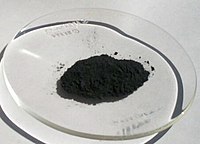
Photo from wikipedia
Conventional technologies for ammonium removal from wastewaters are based on biological conversion to nitrogen gas, eliminating the possibility for ammonium recovery. A new electrochemical approach was developed here to selectively… Click to show full abstract
Conventional technologies for ammonium removal from wastewaters are based on biological conversion to nitrogen gas, eliminating the possibility for ammonium recovery. A new electrochemical approach was developed here to selectively remove ammonium using two copper hexacyanoferrate (CuHCF) battery electrodes separated by an anion exchange membrane, at low applied voltages (0.1 to 0.3 V). The CuHCF battery electrodes removed NH4+ from a synthetic wastewater with a selectivity >5 (i.e., percent removed of NH4+/percent removed of Na+) when operated with a 0.1 V applied voltage, despite the much higher initial Na+ concentration in the sample (20 mM) than NH4+ (5 mM). In contrast, we observed only negligible selective removal of NH4+ over Na+ (<2) when using nonselective electrodes or ion-selective membranes (10 mM Na+, 5 mM NH4+, 0.1 V). The selectivity further increased to 9 when using equimolar concentrations of NH4+ and Na+ (10 mM). With an actual domestic wastewater, the CuHCF electrodes removed 85% of NH4...
Journal Title: Environmental Science and Technology Letters
Year Published: 2018
Link to full text (if available)
Share on Social Media: Sign Up to like & get
recommendations!